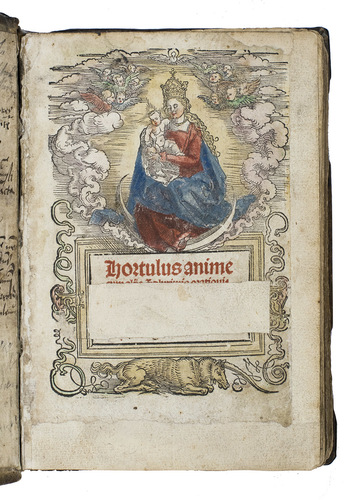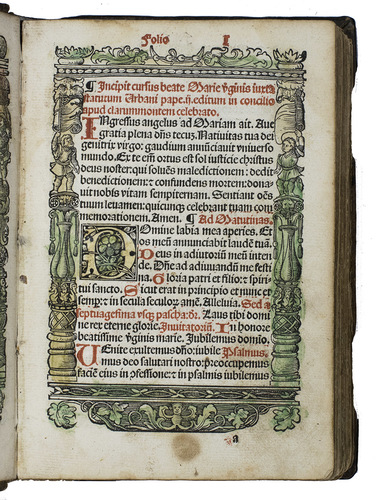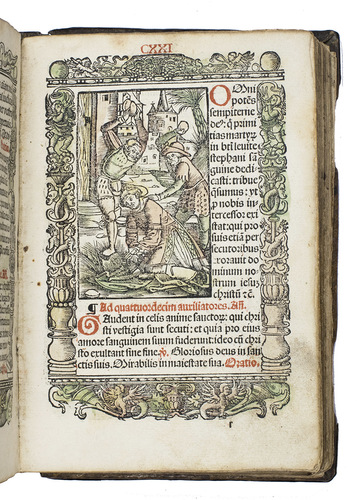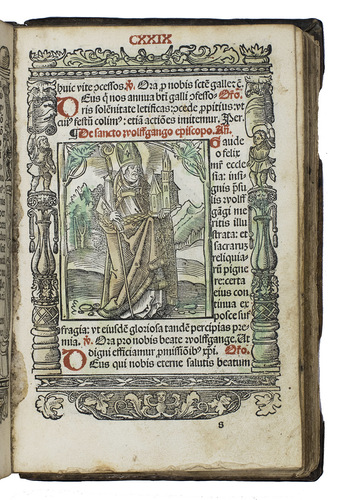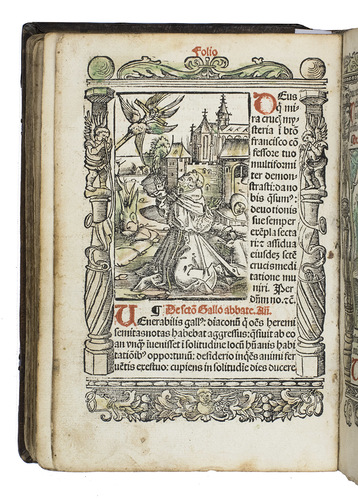[HORTULUS ANIMAE - PRAYERBOOK].
[Hortulus anime cum aliis q[uam] plurimis orationibus pristine impressioni superadditis; ut tabulam in huius calce annexa[m] intue[n]ti pate[n]tissimu[m] erit.].
(colophon:) Lyon, Johannes Clein (for Johannes Koberger, Nürnberg), 15 March 1516. 8vo. With the a decorated woodcut on the title-page with a madonna and child above and a unicorn below a frame for the letterpress title printed in red, Cleins woodcut device on the final recto, further with 89 woodcut illustrations, printed from 86 blocks (in three sizes), including 52 (from 50 blocks) by Hans Springinklee (who also cut the title woodcut), 6 (from 5 blocks) by Erhard Schön and 23 other smaller woodcuts, and the text printed in red and black in gothic rotunda type, each page (except the title-page, Cleins device and a two-page table of moveable feasts), in 1 of 25 different woodcut borders (a few dated) composed of angels, putti, grotesques, vases, fountains and other emblematic and architectural details. Many of the woodcuts are partly coloured by a contemporary hand.
Contemporary blind-tooled calf over wooden boards, sewn on 3 double cords, each board with brass pieces covering the edges at the head and foot, a brass strip near the hinge on the front board (lacking on the back board) and 2 brass catch plates on the front board with traces on the back board of leather straps that would have had brass clasps. [20], CCX, [10] ll.
€ 12,500
The most popular German prayerbook in the early years of the 16th century, here in the first edition with the woodcut illustrations by the Nürnberg engravers Hans Springinklee and Erhard Schön, made for this edition. The Hortulus animae (also called Seelengärtlein in German) was a collection of prayers, often richly illustrated with beautiful woodcuts. It became extremely popular after its first edition, dated 13 March 1498, printed in Strasbourg by William Schaffener of Rappeltsweiler. The present edition, the fourth printed by Johannes Clein in Lyon for the Nürnberg publisher Johannes Koberger, is important in the history of the Hortulus, because it is the first to use a new series of woodcuts made for this edition by Springinklee and Schön. All 18 editions, whether in German or Latin, published between 1516 and 1521, printed variously in Lyon (by Clein) and Nürnberg (by Stüchs or Pepyus) for Anton or Johannes Koberger, have illustrations from the present Springinklee and Schön blocks. With the introduction of these series of woodcuts in the present Clein-Koberger edition, the Hortulus animae became a high point of German book illustration, even in its Latin editions, while the three earlier editions (issued in 1511 and twice in 1513) show miscellaneous woodcuts of uneven quality.
The Hortulus animae contains a collection of prayers - resembling the French Horae B.M.V. and the English primers, such as the Little office of Our Lady - and occupies a great place of honour in these forms of prayer books. Nevertheless, the Hortulus shows a greater variety of popular prayers, including prayers of individual saints. Its collection of prayers, issued for private devotion, is preceded by a calendar of saints days and other feasts, an astrological calendar and a section on solar and lunar phases, the latter including two woodcuts of the sun and moon. The prayers include the Office of the Virgin, Penitential Psalms and other traditional components, but also more popular prayers and a number of "probably spurious indulgences" (Catholic encyclopedia), altogether making it a unique German variation on the more common books of hours or prayer books. The present fourth Clein-Koberger edition is beautifully illustrated with 90 woodcuts from 87 blocks (block of the enthroned Virgin with Child is repeated twice with a different text; the one showing Saint Birgitta is repeated once). The new woodcut series by Springinklee and Schön, commissioned by Johannes Koberger, depict events from Christ's life and various saints with their attributes, sometimes depicted in rural mountainous landscapes in a German style. Most of the woodcuts and some of the borders are coloured by a contemporary hand.
With 16th-century owners' inscriptions in three different hands: one on the first few leaves and the front paste-down; the second appearing on the front paste-down (but faded) and the back paste-down ("Dominicus Gordel"); the third appearing on A3r-v and the back paste-down. Part of the title has been cut out and a slip of blank paper mounted on the back as "restoration" (not affecting the calendar on the verso), the last leaf F4 (the recto with only Cleins device and the verso blank) has most of the foot margin (containing a manuscript inscription, probably naming an owner) torn off and the leaf is mounted on a blank leaf, a few leaves a little chipped, some small marginal tears repaired (n7, o1), a few upper fore-edge corners folded in, edges of some leaves a little browned or slightly stained. The boards rubbed (worse on the front, with 3 gaps in the calf), spine slightly worn, front hinge a little cracked, small piece of the back paste-down lost, but overall still in good condition. A rare Clein-Koberger edition showing the first use of an important series of woodcuts, in this copy party hand-coloured. BM STC French, p. 232; Baudrier Fairfax Murray, German 209; Mortimer, French, 320; Oldenbourg, Hortulus animae, L 62; USTC 144588 (7 copies), 664199 (3 copies); VD16 ZV 26581; this edition not in Adams.
Related Subjects:










